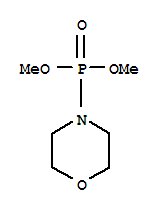| Identification |
| Name: | Phosphonic acid,P-4-morpholinyl-, dimethyl ester |
| Synonyms: | Phosphonicacid, 4-morpholinyl-, dimethyl ester (9CI); Phosphonic acid, morpholino-,dimethyl ester (6CI,7CI,8CI); Dimethyl morpholinophosphonate; Dimethylmorpholinophosphoramidate |
| CAS: | 597-25-1 |
| Molecular Formula: | C6H14 N O4 P |
| Molecular Weight: | 195.18 |
| InChI: | InChI=1/C6H14NO4P/c1-9-12(8,10-2)7-3-5-11-6-4-7/h3-6H2,1-2H3 |
| Molecular Structure: |
 |
| Properties |
| Flash Point: | 103.1°C |
| Boiling Point: | 246.8°C at 760 mmHg |
| Density: | 1.21g/cm3 |
| Refractive index: | 1.454 |
| Specification: |
Dimethylmorpholinophosphonate (CAS NO.597-25-1) is also called 4-27-00-00629 (Beilstein Handbook Reference) ; BRN 0141995 ; CCRIS 1352 ; Dimethyl 4-morpholinylphosphonate ; Dimethyl morpholinophosphoramidate ; HC 1717 ; HSDB 4195 ; Morpholinophosphonic acid dimethyl ester ; NCI-C54740 ; Phosphonic acid, 4-morpholinyl-, dimethyl ester ; Phosphonic acid, 4-morpholinyl-, dimethyl ester (9CI) ; Phosphonic acid, morpholino-, dimethyl ester . Dimethylmorpholinophosphonate (CAS NO.597-25-1) is clear colorless slightly viscous liquid. It is water soluble and slowly hydrolyzes upon exposure to moisture. Reactions Sensitive to prolonged exposure to air. When heated to decomposition Dimethylmorpholinophosphonate (CAS NO.597-25-1) emits very toxic fumes of nitrogen oxides and phosphorous oxides. Dimethylmorpholinophosphonate (CAS NO.597-25-1) is probably combustible.
|
| Report: |
NTP Carcinogenesis Studies (gavage); Some Evidence: rat NTPTR* National Toxicology Program Technical Report Series. (Research Triangle Park, NC 27709) No. NTP-TR-298 ,1986. ; No Evidence: mouse NTPTR* National Toxicology Program Technical Report Series. (Research Triangle Park, NC 27709) No. NTP-TR-298 ,1986. .
|
| Flash Point: | 103.1°C |
| Safety Data |
| |
 |